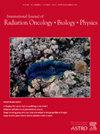早期乳腺癌超高分次全乳腺照射和序贯肿瘤床增强疗法(SHIFT)的早期安全性:多中心 2 期试验
IF 6.4
1区 医学
Q1 ONCOLOGY
International Journal of Radiation Oncology Biology Physics
Pub Date : 2024-10-01
DOI:10.1016/j.ijrobp.2024.07.010
引用次数: 0
摘要
目的/目标)FAST-Forward 3 期试验表明,对早期乳腺癌患者进行全乳腺照射(WBI),一周内分 5 次照射 26 Gy 安全有效,并可进行肿瘤床连续增强(2 Gy 分次照射 10 Gy 或 16 Gy)。目前的试验是,WBI 在一周内分 5 次照射 26 Gy,而肿瘤床连续照射则分 2 次照射 10.4 Gy,每天一次,如果需要肿瘤床连续照射,则放疗(RT)的总疗程不超过 1.5 周。材料/方法这是一项多中心、单臂、2 期试验,在中国 4 家三甲医院进行。年龄在18岁以上的浸润性乳腺癌(pT1-3,N0-1mic,M0)或乳腺导管原位癌(DCIS)肿块切除术后患者均符合条件。所有入选患者均接受了为期5天、分5次、每次26 Gy的WBI治疗。由放射肿瘤科医生决定在2天内分2次对肿瘤床进行10.4 Gy的连续增强。主要终点是RT后6个月内的急性放射毒性,目标是在预计50%的基线≥2级(G2)急性毒性发生率的基础上,达到10%的非劣效边际。急性毒性采用 CTCAE v5.0 进行评估,评估时间为 RT 期间的 1 周和 2 周,以及 RT 结束后的 1 个月和 6 个月。该试验已在 ClinicalTrials.gov 上注册(NCT04926766)。结果从 2021 年 1 月到 2023 年 7 月,217 名患者的招募工作已经完成,其中 210 人接受了肿瘤床增强治疗。RT后6个月内,157例(72.4%)患者仅出现G1急性毒性,16例(7.4%)患者出现G2急性毒性,未观察到G3事件。44例(20.3%)患者未报告任何毒性事件。各时间点的详细评估结果见表 1。122 名患者在 RT 结束后 6 个月进行了胸部 CT 评估,其中 26 人(21%)出现了 G1 放射性肺炎。RT后超声心动图或心脏生物标志物未发现明显变化。中位随访时间为16.3个月(四分位数间距[IQR] = 7.3至37.6),未发现严重毒性反应,也未发生局部复发、远处转移或死亡。结论早期乳腺癌患者在1.5周内接受WBI和肿瘤床序贯增强的超高分次RT治疗(每分次5.2 Gy)耐受性良好。需要进一步随访以评估晚期毒性和长期疗效。本文章由计算机程序翻译,如有差异,请以英文原文为准。
Early Safety of Ultra-Hypofractionated Whole Breast Irradiation and Sequential Tumor Bed Boost for Early Breast Cancer (SHIFT): A Multicenter, Phase 2 Trial
Purpose/Objective(s)
The Phase 3 FAST-Forward trial showed that 26 Gy in 5 fractions over 1 week for whole breast irradiation (WBI) was safe and efficacy for early breast cancer patients, in which a sequential tumor bed boost was allowed (10 Gy or 16 Gy in 2-Gy fractions). Current trial delivers 26 Gy in 5 fractions over 1 week for WBI and 10.4 Gy in 2 fractions once daily for sequential tumor bed boost, to keep the total duration of radiotherapy (RT) to no more than 1.5 weeks if tumor bed boost is required. Here we report the early safety of this ultra-hypofractionation regimen.
Materials/Methods
This is a multicenter, single-arm, phase 2 trial carried out at 4 tertiary hospitals in China. Patients aged at least 18 years with invasive breast carcinoma (pT1-3, N0-1mic, M0) or ductal carcinoma in situ (DCIS) after lumpectomy were eligible. All enrolled patients underwent WBI of 26 Gy in 5 fractions over 5 days. A sequential tumor bed boost of 10.4 Gy in 2 fractions over 2 days was at the discretion of radiation oncologist. The primary endpoint was acute radiation-induced toxicity within 6 months after RT, aiming for a 10% non-inferiority margin based on a projected 50% baseline incidence of ≥Grade 2 (G2) acute toxicity. Acute toxicity was assessed using CTCAE v5.0 at 1 week and 2 weeks during RT, and at 1 month and 6 months after RT completion. This trial is registered at ClinicalTrials.gov (NCT04926766).
Results
Between January 2021, and July 2023, recruitment of 217 patients has been completed, of whom 210 received tumor bed boost. Within 6 months after RT, 157 (72.4%) patients experienced G1 acute toxicity only, 16 (7.4%) patients experienced G2 acute toxicity, with no G3 events observed. No toxicity event was reported in 44 (20.3%) patients. Detailed assessments at each time point are presented in Table 1. Of the 122 patients who had chest CT for evaluation at 6 months after RT, 26 (21%) experienced G1 radiation pneumonitis. No significant changes in echocardiography or cardiac biomarkers after RT were found. At a median follow-up of 16.3 months (interquartile range [IQR] = 7.3 to 37.6), no severe toxicities were found, and no locoregional recurrence, distant metastasis or death occurred. A second primary cancer of urothelial carcinoma was reported in a patient with germline BRCA1/2 mutation.
Conclusion
Ultra-hypofractionated RT of WBI and sequential tumor bed boost administrated within 1.5 weeks using 5.2 Gy per fraction is well-tolerated in early breast cancer patients. Further follow-up is needed in order to assess late toxicity and long-term efficacy.
求助全文
通过发布文献求助,成功后即可免费获取论文全文。
去求助
来源期刊
CiteScore
11.00
自引率
7.10%
发文量
2538
审稿时长
6.6 weeks
期刊介绍:
International Journal of Radiation Oncology • Biology • Physics (IJROBP), known in the field as the Red Journal, publishes original laboratory and clinical investigations related to radiation oncology, radiation biology, medical physics, and both education and health policy as it relates to the field.
This journal has a particular interest in original contributions of the following types: prospective clinical trials, outcomes research, and large database interrogation. In addition, it seeks reports of high-impact innovations in single or combined modality treatment, tumor sensitization, normal tissue protection (including both precision avoidance and pharmacologic means), brachytherapy, particle irradiation, and cancer imaging. Technical advances related to dosimetry and conformal radiation treatment planning are of interest, as are basic science studies investigating tumor physiology and the molecular biology underlying cancer and normal tissue radiation response.

 求助内容:
求助内容: 应助结果提醒方式:
应助结果提醒方式:


